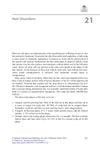Epidermal Nevi
October 2010
in “
Pediatric Clinics of North America
”
TLDR Epidermal nevi are skin cell clusters linked to various syndromes.
Epidermal nevi were typically noted at birth or within the first year as linear tan patches or thin plaques, often following Blaschko lines. Nevus sebaceous presented at birth as yellow-orange to pink alopecic plaques, varying in size, and could be associated with multiple lesions. Nevus comedonicus appeared as linear arrays of dilated follicular orifices resembling comedones, often on the face, neck, or trunk. Becker nevus, more common in young men, presented as hyperpigmented patches on the trunk or upper extremities. Inflammatory linear verrucous epidermal nevus (ILVEN) was characterized by pruritic erythematous scaly papules and plaques. Porokeratotic eccrine ostial and dermal duct nevus (PEODDN) presented as hyperkeratotic papules and plaques, often on the palms or soles. Epidermal nevus syndrome described the association of epidermal nevi with systemic features affecting multiple organs, including neurologic, ocular, skeletal, and occasionally cardiac and renal anomalies.
